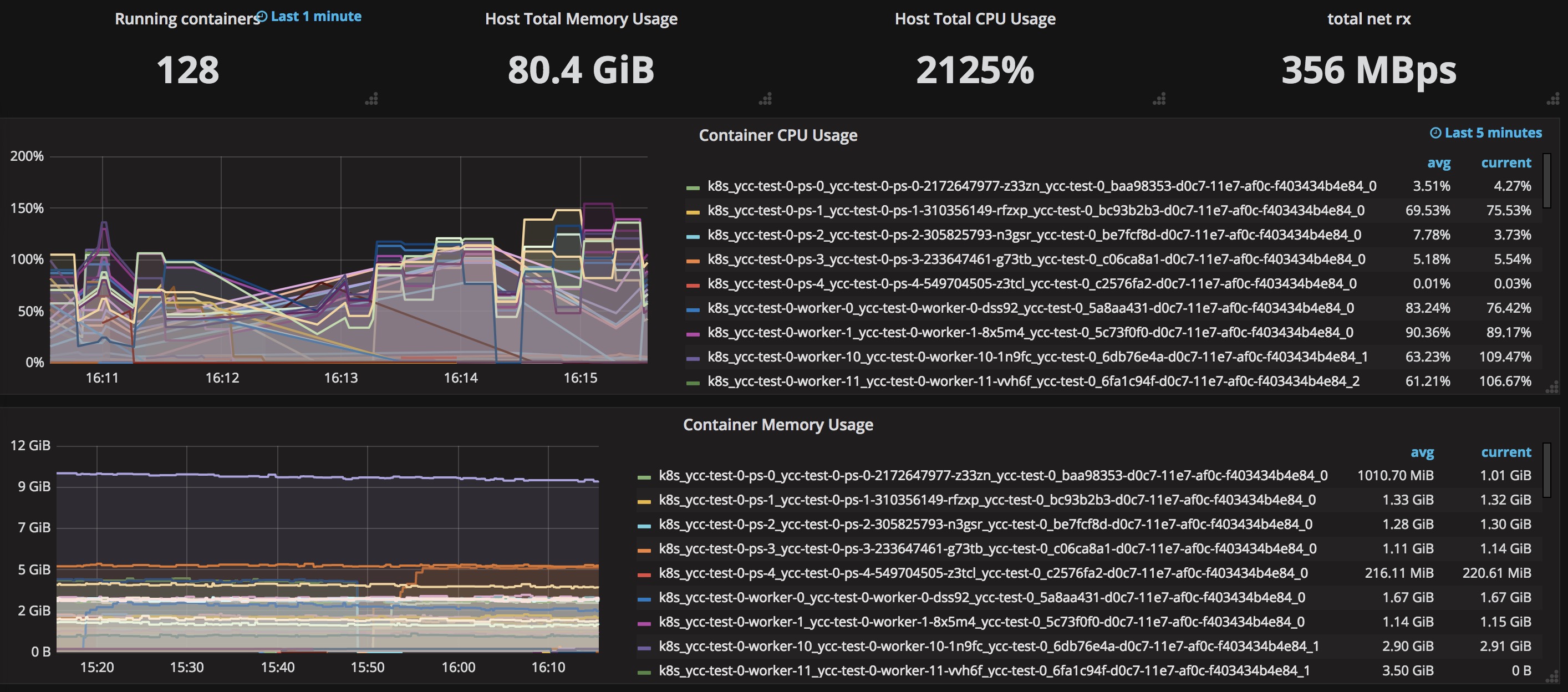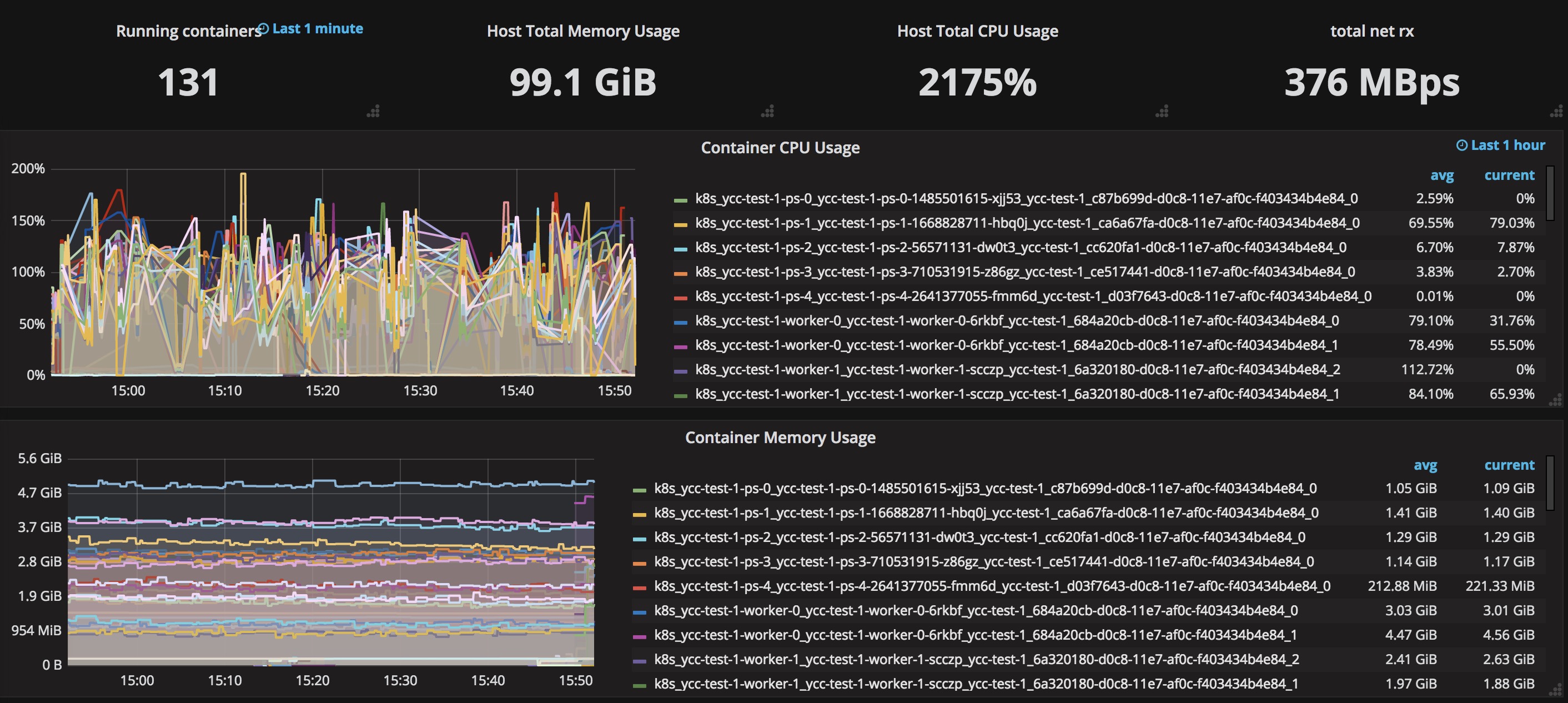本篇内容介绍了“TensorFlow on Kubernetes性能怎么理解”的有关知识,在实际案例的操作过程中,不少人都会遇到这样的困境,接下来就让小编带领大家学习一下如何处理这些情况吧!希望大家仔细阅读,能够学有所成!
增加worker数,一定范围内能带来较好的性能提升,但是继续增加worker数时,训练性能提升不明显;
增加ps数,一定范围内能带来较好的性能提升,但是继续增加ps数时,训练性能提升不明显;
可能原因:
与ps和worker的分布情况强相关:
目前的调度策略,主要根据服务器的cpu和内存使用情况进行均衡调度,尽量使得集群中每台服务器的cpu和内存使用率相当。这种情况下,ps和worker的调度存在一定程度的随机性。
如果调度时,每台包含worker的服务器都有对应一个ps,那么训练性能会更高?如果有,性能提升多少呢?
K8S中的worker从HDFS集群中读取训练数据时存在IO瓶颈?可能网络上的或者是HDFS本身的配置,需要通过HDFS集群的监控来进一步排查。
下面,是针对第一种“可能原因:与ps和worker的分布情况强相关“ 设计的测试场景和用例:
| 用例ID | 服务器数 | worker数 | ps数 | 说明 |
|---|---|---|---|---|
| 1 | 1 | 10 | 1 | 一台服务器部署了10个worker和1个ps |
| 2 | 5 | 50 | 5 | 5台服务器分别部署了10个worker和1个p |
| 3 | 10 | 100 | 10 | 10台服务器分别部署了10个worker和1个p |
| 4 | 20 | 200 | 20 | 20台服务器分别部署了10个worker和1个p |

场景1的TensorFlow对象模板scene1.jinja
# scene1.jinja —— 对象模板
{%- set name = "##NAME##" -%}
{%- set worker_replicas = ##WN## -%}
{%- set ps_replicas = ##PN## -%}
{%- set script = "##SCRIPT##" -%}
{%- set case = "##CASE##" -%}
{%- set port = 2222 -%}
{%- set log_host_dir = "/var/log/tensorflow" -%}
{%- set log_container_dir = "/var/log" -%}
{%- set image = "registry.vivo.xyz:4443/bigdata_release/tensorflow1.3.0" -%}
{%- set replicas = {"worker": worker_replicas, "ps": ps_replicas} -%}
{%- macro worker_hosts() -%}
{%- for i in range(worker_replicas) -%}
{%- if not loop.first -%},{%- endif -%}
{{ name }}-worker-{{ i }}:{{ port }}
{%- endfor -%}
{%- endmacro -%}
{%- macro ps_hosts() -%}
{%- for i in range(ps_replicas) -%}
{%- if not loop.first -%},{%- endif -%}
{{ name }}-ps-{{ i }}:{{ port }}
{%- endfor -%}
{%- endmacro -%}
{%- for i in range( begin_index, end_index ) -%}
{%- if task_type == "worker" %}
---
kind: Service
apiVersion: v1
metadata:
name: {{ name }}-{{ task_type }}-{{ i }}
namespace: {{ name }}
spec:
clusterIP: None
selector:
name: {{ name }}
job: {{ task_type }}
task: "{{ i }}"
ports:
- port: {{ port }}
targetPort: 2222
---
kind: Job
apiVersion: batch/v1
metadata:
name: {{ name }}-{{ task_type }}-{{ i }}
namespace: {{ name }}
spec:
template:
metadata:
labels:
name: {{ name }}
job: {{ task_type }}
task: "{{ i }}"
spec:
imagePullSecrets:
- name: harborsecret'
affinity:
nodeAffinity:
requiredDuringSchedulingIgnoredDuringExecution:
nodeSelectorTerms:
- matchExpressions:
- key: "CASE"
operator: In
values:
- "{{ case }}"
- key: "INDEX"
operator: In
values:
- "{{ i // 10 }}"
- key: "SCENCE"
operator: In
values:
- "1"
containers:
- name: {{ name }}-{{ task_type }}-{{ i }}
image: {{ image }}
resources:
requests:
memory: "4Gi"
cpu: "300m"
ports:
- containerPort: 2222
command: ["/bin/sh", "-c", "export CLASSPATH=.:/usr/lib/jvm/java-1.8.0/lib/tools.jar:$(/usr/lib/hadoop-2.6.1/bin/hadoop classpath --glob); wget -r -nH -np --cut-dir=1 -R 'index.html*,*gif' {{ script }}; cd ./{{ name }}; sh ./run.sh {{ ps_hosts() }} {{ worker_hosts() }} {{ task_type }} {{ i }} {{ ps_replicas }} {{ worker_replicas }}"]
restartPolicy: OnFailure
{%- endif -%}
{%- if task_type == "ps" -%}
---
kind: Service
apiVersion: v1
metadata:
name: {{ name }}-{{ task_type }}-{{ i }}
namespace: {{ name }}
spec:
clusterIP: None
selector:
name: {{ name }}
job: {{ task_type }}
task: "{{ i }}"
ports:
- port: {{ port }}
targetPort: 2222
---
kind: Deployment
apiVersion: extensions/v1beta1
metadata:
name: {{ name }}-{{ task_type }}-{{ i }}
namespace: {{ name }}
spec:
replicas: 1
template:
metadata:
labels:
name: {{ name }}
job: {{ task_type }}
task: "{{ i }}"
spec:
imagePullSecrets:
- name: harborsecret
affinity:
nodeAffinity:
requiredDuringSchedulingIgnoredDuringExecution:
nodeSelectorTerms:
- matchExpressions:
- key: "CASE"
operator: In
values:
- "{{ case }}"
- key: "INDEX"
operator: In
values:
- "{{ i }}"
- key: "SCENCE"
operator: In
values:
- "1"
containers:
- name: {{ name }}-{{ task_type }}-{{ i }}
image: {{ image }}
resources:
requests:
memory: "4Gi"
cpu: "2"
ports:
- containerPort: 2222
command: ["/bin/sh", "-c","export CLASSPATH=.:/usr/lib/jvm/java-1.8.0/lib/tools.jar:$(/usr/lib/hadoop-2.6.1/bin/hadoop classpath --glob); wget -r -nH -np --cut-dir=1 -R 'index.html*,*gif' {{ script }}; cd ./{{ name }}; sh ./run.sh {{ ps_hosts() }} {{ worker_hosts() }} {{ task_type }} {{ i }} {{ ps_replicas }} {{ worker_replicas }}"]
restartPolicy: Always
{%- endif -%}
{%- endfor -%}Label Nodes
选择对应的节点打上对应的Label。
kubectl label node $node_name SCENCE=1 CASE=? INDEX=?
用例2的测试截图:

| 用例ID | 服务器数 | worker数 | ps数 | 说明 |
|---|---|---|---|---|
| 1 | 2 | 10 | 1 | 一台服务器部署10个worker,另外一台部署1个ps |
| 2 | 10 | 20 | 5 | 5台服务器分别部署10个worker,5台服务器分别部署1个ps |
| 3 | 20 | 50 | 10 | 10台服务器分别部署10个worker,10台服务器分别部署1个ps |
| 4 | 40 | 200 | 20 | 20台服务器分别部署10个worker,20台服务器分别部署1个ps |

场景2的TensorFlow对象模板scene2.jinja
# scene2.jinja —— 对象模板
{%- set name = "##NAME##" -%}
{%- set worker_replicas = ##WN## -%}
{%- set ps_replicas = ##PN## -%}
{%- set script = "##SCRIPT##" -%}
{%- set case = "##CASE##" -%}
{%- set port = 2222 -%}
{%- set log_host_dir = "/var/log/tensorflow" -%}
{%- set log_container_dir = "/var/log" -%}
{%- set image = "registry.vivo.xyz:4443/bigdata_release/tensorflow1.3.0" -%}
{%- set replicas = {"worker": worker_replicas, "ps": ps_replicas} -%}
{%- macro worker_hosts() -%}
{%- for i in range(worker_replicas) -%}
{%- if not loop.first -%},{%- endif -%}
{{ name }}-worker-{{ i }}:{{ port }}
{%- endfor -%}
{%- endmacro -%}
{%- macro ps_hosts() -%}
{%- for i in range(ps_replicas) -%}
{%- if not loop.first -%},{%- endif -%}
{{ name }}-ps-{{ i }}:{{ port }}
{%- endfor -%}
{%- endmacro -%}
{%- for i in range( begin_index, end_index ) -%}
{%- if task_type == "worker" %}
---
kind: Service
apiVersion: v1
metadata:
name: {{ name }}-{{ task_type }}-{{ i }}
namespace: {{ name }}
spec:
clusterIP: None
selector:
name: {{ name }}
job: {{ task_type }}
task: "{{ i }}"
ports:
- port: {{ port }}
targetPort: 2222
---
kind: Job
apiVersion: batch/v1
metadata:
name: {{ name }}-{{ task_type }}-{{ i }}
namespace: {{ name }}
spec:
template:
metadata:
labels:
name: {{ name }}
job: {{ task_type }}
task: "{{ i }}"
spec:
imagePullSecrets:
- name: harborsecret'
affinity:
nodeAffinity:
requiredDuringSchedulingIgnoredDuringExecution:
nodeSelectorTerms:
- matchExpressions:
- key: "CASE"
operator: In
values:
- "{{ case }}"
- key: "INDEX"
operator: In
values:
- "{{ i // 10 }}"
- key: "SCENCE"
operator: In
values:
- "2"
- key: "TYPE"
operator: In
values:
- "worker"
containers:
- name: {{ name }}-{{ task_type }}-{{ i }}
image: {{ image }}
resources:
requests:
memory: "4Gi"
cpu: "300m"
ports:
- containerPort: 2222
command: ["/bin/sh", "-c", "export CLASSPATH=.:/usr/lib/jvm/java-1.8.0/lib/tools.jar:$(/usr/lib/hadoop-2.6.1/bin/hadoop classpath --glob); wget -r -nH -np --cut-dir=1 -R 'index.html*,*gif' {{ script }}; cd ./{{ name }}; sh ./run.sh {{ ps_hosts() }} {{ worker_hosts() }} {{ task_type }} {{ i }} {{ ps_replicas }} {{ worker_replicas }}"]
restartPolicy: OnFailure
{%- endif -%}
{%- if task_type == "ps" -%}
---
kind: Service
apiVersion: v1
metadata:
name: {{ name }}-{{ task_type }}-{{ i }}
namespace: {{ name }}
spec:
clusterIP: None
selector:
name: {{ name }}
job: {{ task_type }}
task: "{{ i }}"
ports:
- port: {{ port }}
targetPort: 2222
---
kind: Deployment
apiVersion: extensions/v1beta1
metadata:
name: {{ name }}-{{ task_type }}-{{ i }}
namespace: {{ name }}
spec:
replicas: 1
template:
metadata:
labels:
name: {{ name }}
job: {{ task_type }}
task: "{{ i }}"
spec:
imagePullSecrets:
- name: harborsecret
affinity:
nodeAffinity:
requiredDuringSchedulingIgnoredDuringExecution:
nodeSelectorTerms:
- matchExpressions:
- key: "CASE"
operator: In
values:
- "{{ case }}"
- key: "INDEX"
operator: In
values:
- "{{ i }}"
- key: "SCENCE"
operator: In
values:
- "2"
- key: "TYPE"
operator: In
values:
- "ps"
containers:
- name: {{ name }}-{{ task_type }}-{{ i }}
image: {{ image }}
resources:
requests:
memory: "4Gi"
cpu: "2"
ports:
- containerPort: 2222
command: ["/bin/sh", "-c","export CLASSPATH=.:/usr/lib/jvm/java-1.8.0/lib/tools.jar:$(/usr/lib/hadoop-2.6.1/bin/hadoop classpath --glob); wget -r -nH -np --cut-dir=1 -R 'index.html*,*gif' {{ script }}; cd ./{{ name }}; sh ./run.sh {{ ps_hosts() }} {{ worker_hosts() }} {{ task_type }} {{ i }} {{ ps_replicas }} {{ worker_replicas }}"]
restartPolicy: Always
{%- endif -%}
{%- endfor -%}Label Nodes
选择对应的节点打上对应的Label。
kubectl label node $node_name SCENCE=1 CASE=? INDEX=? TYPE=?
用例2的测试截图:

对比两种不同场景下用例2(5个ps,50个worker)的监控数据,发现如下现象:
两种场景下,虽然创建了5个ps,但是实际上只有一个ps的负载比较高,其他的ps要么cpu usage在10%以下,要么甚至几乎为0。
两种场景下同样的worker number和ps number,整个tensorflow cluster消耗的cpu和内存差别很小。
分布式tensorflow中,每个worker选择哪个ps作为自己的参数服务器跟我们如何强制分布ps和worker的布局无关,由分布式tensorflow内部自己控制(跟tf.train.replica_device_setter()设置的strategy有关)。
为什么这个训练中,多个ps中只有一个ps在工作?是算法只有一个Big参数?如果是,那么默认按照Round-Robin策略只会使用一个ps,就能解释这个问题了。这需要算法的兄弟进行确认。
如果将Big参数拆分成众多Small参数,使用RR或LB或Partition策略之一,应该都能利用多个ps进行参数更新明显提升训练性能。
通过这次折腾,也不是一无所获,至少发现我们对于Distributed TensorFlow的内部工作原理还不甚了解,非常有必要深入到源码进行分析。
“TensorFlow on Kubernetes性能怎么理解”的内容就介绍到这里了,感谢大家的阅读。如果想了解更多行业相关的知识可以关注亿速云网站,小编将为大家输出更多高质量的实用文章!
免责声明:本站发布的内容(图片、视频和文字)以原创、转载和分享为主,文章观点不代表本网站立场,如果涉及侵权请联系站长邮箱:is@yisu.com进行举报,并提供相关证据,一经查实,将立刻删除涉嫌侵权内容。